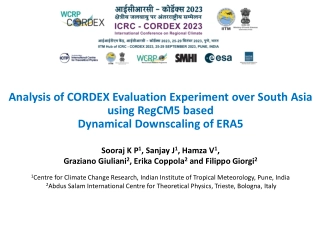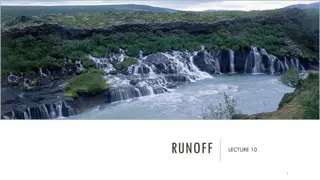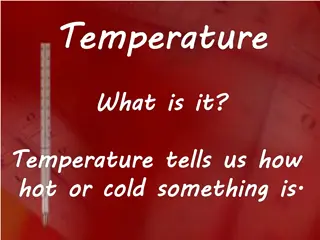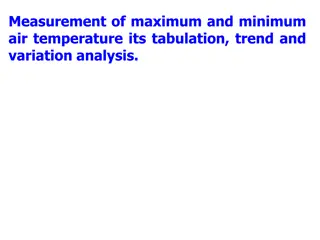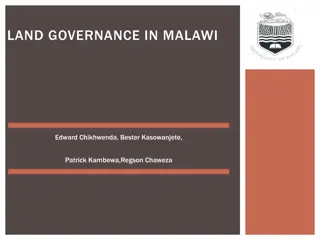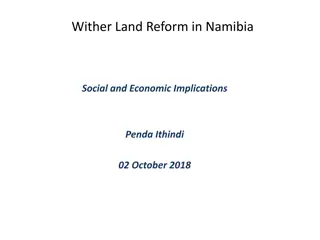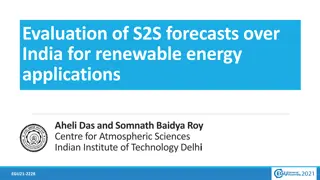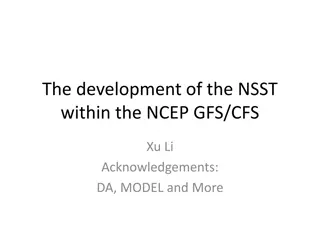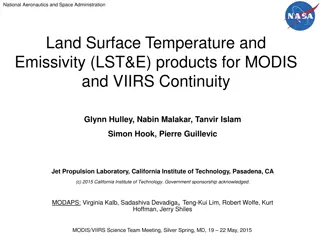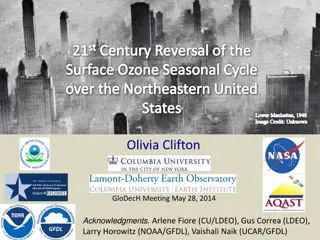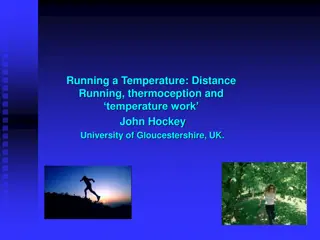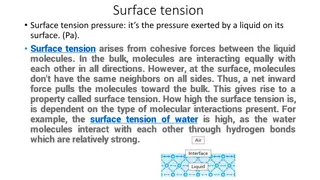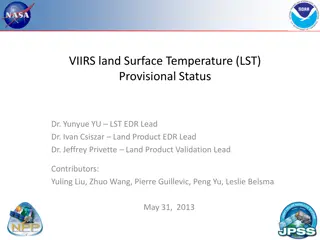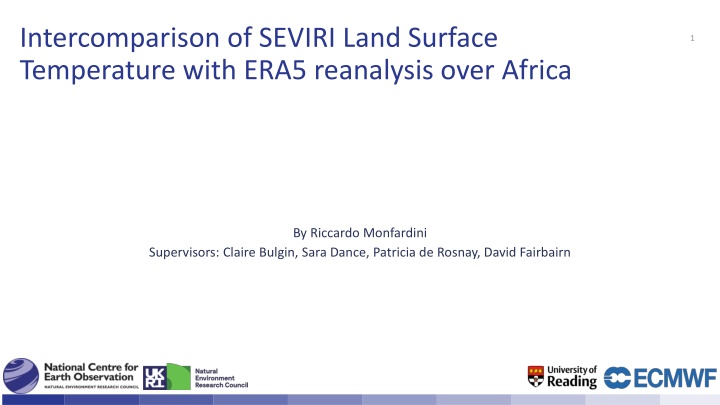
Intercomparison of SEVIRI Land Surface Temperature with ERA5 Reanalysis in Africa
This study by Riccardo Monfardini aims to assess diurnal discrepancies between high-frequency Land Surface Temperature (LST) retrievals from geostationary satellites and ERA5 skin temperature over Africa. The research, supervised by Claire Bulgin, Sara Dance, Patricia de Rosnay, and David Fairbairn, focuses on preparing for the future assimilation of LST data in Numerical Weather Models. Data sources include LST retrieval from SEVIRI and reanalysis data from ECMWF. The analysis is conducted over a 5-year period and grouped by hour in the African domain.
Download Presentation

Please find below an Image/Link to download the presentation.
The content on the website is provided AS IS for your information and personal use only. It may not be sold, licensed, or shared on other websites without obtaining consent from the author. If you encounter any issues during the download, it is possible that the publisher has removed the file from their server.
You are allowed to download the files provided on this website for personal or commercial use, subject to the condition that they are used lawfully. All files are the property of their respective owners.
The content on the website is provided AS IS for your information and personal use only. It may not be sold, licensed, or shared on other websites without obtaining consent from the author.
E N D
Presentation Transcript
Intercomparison of SEVIRI Land Surface Temperature with ERA5 reanalysis over Africa 1 By Riccardo Monfardini Supervisors: Claire Bulgin, Sara Dance, Patricia de Rosnay, David Fairbairn
Aim and sources 2 Aim: To use high frequency LST retrievals from geostationary satellites to assess diurnal discrepancies with ERA5 skin temperature Motivation: Extending work done by Johannsen et al, and preparatory work for future data assimilation of LST in Numerical Weather Models
Data Sources 3 LST retrieval ERA5 SEVIRI MSG data from Land Surface Analysis of the Satellite Application Facility Resolution: 0.05 Frequency: 15 min Reanalysis data from ECMWF, that blends model and observations to get a map without gaps of the past Resolution: 0.25 Frequency: 1 hour Skin temperature (skt): the uppermost surface layer (over ground, snow, vegetation canopy) with no thickness Land Surface Temperature (LST): The radiative skin temperature over land of the first ~50 m. The infrared retrieval needs cloud free skies
Data Sources 4 LST retrieval ERA5 SEVIRI MSG data from Land Surface Analysis of the Satellite Application Facility Resolution: 0.05 Frequency: 15 min Reanalysis data from ECMWF, that blends model and observations to get a map without gaps of the past Resolution: 0.25 Frequency: 1 hour Skin temperature (skt): The temperature of the uppermost surface layer (over ground, snow, vegetation canopy) with no thickness Land Surface Temperature (LST): The radiative skin temperature over land of the first ~50 m. The infrared retrieval needs cloud free skies
Data availability 5 LST data coarsen to ERA5 0.25 , taking the mean of underlying pixels Cloud filters: ERA5 total cloud cover < 0.01 valid fraction of LST pixels in coarser resolution > 0.99
ERA5 skt vs SEVIRI retrieved LST 6 5 year period: 2018-2022 Grouped by hour, corrected for local solar time African domain 40N 55E 25W 40S
ERA5 skt vs SEVIRI retrieved LST 7 ERA5 Daytime 06-17 -1.5 1.0 K largest -3.2 K Nighttime 18-05 0.7 0.7 K largest +1.1K Full day 0-24 -0.4 0.6 K largest -3.17 K
Daytime (06-17): -1.5 1.0 K largest -3.17 Daytime 8
Nighttime (18-05): 0.7 0.7 K largest 1.10 K Nighttime 9
Biome specific examples with CCI Land Cover data 10 Year: 2020 Using CCI Land Cover data to isolate specific biome. Only considering highly homogeneous areas. Year: 2020
ERA5 Land 11 ERA5 Land is enhanced reanalysis of the land component of ERA5. Resolution: 0.1 Frequency: 1 hour Model: more modern IFS cycle 45r2 + HTESSEL (ERA5 uses cycle 41r2) Data assimilation: None, but ERA5 atmospheric forcing + altitude correction
ERA5 Land skt vs SEVIRI retrieved LST 12 Updated std ERA5 LAND ERA5 Daytime 06-17 -2.1 1.1 K largest -5.4 -1.5 1.0 K largest -3.2 K Nighttime 18-05 1.7 0.8 K largest 5.3 0.7 0.7 K largest +1.1 K Full day 0-24 -0.2 0.7 K largest -5.4 -0.4 0.6 K largest -3.17 K
Concluding remarks 13 A comparison between SEVIRI LST and ERA5 skt 2018-2022 ERA5 skt diurnal range is too limited in clear skies Small warm bias during nighttime Large cold bias during daytime hours This bias is strongly influenced by location/biome ERA5 Land higher resolution still has bias, shifted by lack of data assimilation

